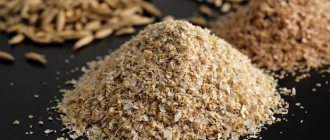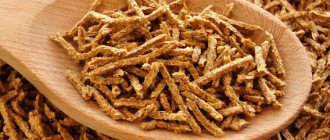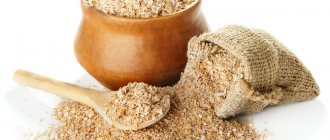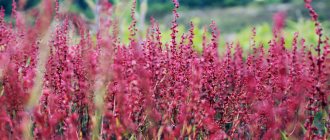Just some 30 years ago, bran was considered nothing more than animal feed. But even then, the first nutritionists and representatives of the food industry realized that this product had great potential and benefits for humans. Today, when we hear the word “bran,” we think of healthy eating, valuable fiber, and advice from a fitness trainer.
In this article we have collected the most important information about everything related to bran and the rules for their use.
What is bran
All grains undergo two types of processing aimed at removing excess. First, the husk (the so-called chaff, the inedible “wrapper” of each grain) is removed. Then the outer protective layer, which is part of the grain itself, its “skin,” is removed, resulting in producers receiving grain that is completely (or almost completely) devoid of the shell, and the byproduct of this cleaning is bran.
Bran is the hard outer layer of the grain containing various nutrients and fiber.
Why do you need to remove the shell at all if it is so rich in beneficial nutrients? The answer is simple: unprocessed grains spoil faster and acquire a bitter taste. That is, in this way manufacturers extend the shelf life of the product.
A little history
Until the twentieth century, bran in Russia (and throughout Europe) was considered about the same garbage as chaff. After cleaning, everything except the grains was usually thrown away or, at best, given as feed to domestic animals. Only towards the end of the twentieth century, nutrition researchers were able to prove that the grain shell is a valuable product that can and should be eaten. From that moment on, a new milestone began in the history of bran, marked by respect and recognition.
Chemical composition of bran
It is difficult not to recognize the value of a product that contains so many microelements, antioxidants, essential fatty acids, proteins and slow carbohydrates. The chemical composition of different types of bran can differ significantly, but almost all bran contains the following substances to one degree or another:
- vitamins of group B, as well as A, E and PP,
- calcium,
- potassium,
- phosphorus,
- iron,
- copper,
- manganese,
- zinc,
- selenium.
Nutritional value of bran
Bran varies greatly in caloric content. The “lightest” are rye (just over 100 kcal), the most nutritious are barley (over 400 kcal per 100 g).
Wheat bran with milk thistle
A product of natural origin containing dietary fiber from cereals, it is recommended for a healthy diet. For its manufacture the following are used:
- milk thistle meal;
- wheat bran (unprocessed);
- calcium carbonate.
Salt is added to enhance the taste.
Purpose:
- normalization of the gastrointestinal tract;
- decreased appetite;
- prevention of dysbacteriosis;
- lowering cholesterol levels;
- colon cleansing;
- maintaining the functions of the biliary tract and liver.
The product is intended for adults. Used as a dietary supplement. The daily norm is 60 g, which corresponds to 12 tablespoons. It is better to start using 2-3 tbsp. l. per day, gradually increasing the dose. Fiber is taken with meals, washed down with purified liquid (200 ml). You can also add the product to cereals, soups and other dishes. The easiest way involves mixing cereals with fermented milk drinks. You need to drink them after the dry preparation has swelled.
The cost of a 200 g package is 59 rubles.
By composition
Natural
Natural bran is a product that contains nothing but bran itself. They are good for their simplicity and are suitable for those who like to add additional flavors themselves.
With additives
Such bran may contain salt, kelp, milk thistle, vitamin complexes, particles of nuts or fruits, even spices and... pine needles. Bran with additives is very convenient to use as a base for smoothies, cocktails and breakfasts.
Contraindications and harm
A seemingly harmless product can cause harm to health if contraindications are neglected. Restrictions apply to people who have diseases of the duodenum. Also, those who have been diagnosed with the following pathologies should avoid using bran:
- pancreatitis;
- hepatitis;
- chronic gastritis.
To eliminate risk factors, it is recommended to consult a doctor before consuming wheat bran.
You should avoid using bran if you have gluten intolerance. An increased content of this substance is a reason to control product consumption when losing weight. Nutritionists do not recommend using more than 1 tablespoon of grain peels per day.
Bran for weight loss
One of the most popular reasons for adding bran to your diet is to lose or control weight. Bran by itself is not a “magic pill” and does not help you lose weight, but in an integrated approach to solving this issue, they provide good help.
Bran is a nourishing, but in most cases not particularly high-calorie food, which, on the one hand, helps suppress hunger for a long time, and on the other, cleanses the intestines, removing excess toxins, and normalizes its functioning. At the same time, bran contains enough useful substances that it can make up a good percentage of the daily carbohydrate requirement.
What are the benefits of wheat bran for the body?
Wheat bran is widely used in folk medicine due to its valuable chemical composition, which includes vitamins and minerals important for the body. The greatest benefit is fiber. It, in combination with other microelements, provides the following effect:
- reduces blood viscosity, which prevents the formation of blood clots;
- cleanses the body of waste and toxins;
- restores acid-base balance;
- improves fat, protein and energy metabolism.
Course use of bran improves the functioning of individual organs and systems:
- regulates the functioning of the stomach, which helps in the fight against dysbiosis;
- restores the nervous system;
- normalizes blood sugar levels.
Among other things, there is a cosmetic effect. Calcium, zinc and other valuable minerals improve the condition of hair, nails, and epidermis. By introducing wheat bran into the diet, it is possible to prevent overeating and control your own weight.
Fiber cleanses the intestinal walls, ensures the removal from the body of breakdown products that disrupt the microflora.
Wheat peels contain Omega-3 and Omega-6 acids. These substances have a beneficial effect on the functioning of the cardiovascular system. A course of consumption of crushed grain shells is a good prevention of atherosclerosis, tachycardia, and ischemia. By including the product in your diet after a couple of weeks, you can note the following results:
- restoration of psycho-emotional background;
- improving the functioning of the digestive system;
- improving the functioning of the circulatory system;
- regulation of metabolic processes in the body.
According to research data, purification from wheat prevents the development of cancer. The product also prolongs sexual activity.
Wheat bran with kefir for weight loss
One of the ways to lose weight involves the use of kefir with wheat peelings. Fermented milk drink normalizes microflora, stimulates intestinal motility, and restores the functioning of the digestive system.
Due to the content of coarse fiber, bran provides intensive cleansing of the body and normalization of blood sugar levels. The components complement each other perfectly and enhance the effect. Food is digested faster, while the feeling of satiety remains for a long time.
There are many options for diets based on kefir and bran. The three-day course is popular. You won’t be able to lose much during this period, but you will have a good chance to cleanse your body of toxins, switch to proper nutrition, and establish a water-salt balance. You can also monitor your weight by drinking a fermented milk drink instead of dinner every day. To do this, let kefir (200 ml) warm up at room temperature, add 1 tsp. fiber. As soon as the dry preparation swells, the drink is drunk.
How to take for constipation
A bran decoction will help improve intestinal function. It is prepared as follows:
- 4 tablespoons of ground billets are poured into 200 ml of boiling water;
- let the broth brew under the lid for at least 4 hours;
- the resulting mixture is filtered through cheesecloth.
The liquid is consumed 50 ml three times a day.
Reference! It is not recommended to consume fiber in dry form for constipation. Before using the product, you need to steam the raw materials with boiling water. It is not worth preparing the decoction for several days in advance; it is better to brew a fresh portion each time.
A good addition to the broth is to add flakes or ground grains to soups, salads, and main courses.
For gastritis
For chronic gastritis, taking bran is not recommended. During the period of remission, they are allowed to be added to the diet. The product should not be used in dry form, so as not to provoke irritation of the walls of the esophagus and stomach. It is better to prepare soups, porridges and other dishes based on wheat grain shells, which involve mixing the ingredients with water. The simplest option for preparing raw materials for use is steaming with boiling water. The food supplement is infused under a closed lid for at least 50-60 minutes. This use eliminates heavy stress on the stomach. Another advantage is the preservation of most of the valuable microelements.
Reference! For gastritis, you can take bran soaked in cold water only with the approval of a doctor.
How to cook and eat bran
Bran tolerates heat treatment well, so you can eat it both raw and cooked.
The easiest way to introduce bran into your diet is to add it to dairy products (yogurt, kefir, fermented baked milk, matsoni). For this method, you do not need to look for a special recipe or calculate the norm in grams; just mix a few tablespoons of bran with a thick dairy product - and you will get a nutritious, complete breakfast, rich in proteins, fats and carbohydrates. As an alternative, you can take a smoothie as a basis and mix bran with the juice and pulp of fruits, vegetables, berries and herbs.
If the taste of such dishes does not seem particularly attractive to you, you should choose the second method - with heat treatment. Bran can be added to any dough of your choice - pancake, bread, buns or pancakes. Also, many housewives put bran in minced meat for cutlets, hedgehogs or meatballs. They are also very good in porridge.
Another simple and quick way to add bran to the menu is to sprinkle it on the finished salad. This is not an option for everyone and is not suitable for everyone, but it’s worth a try: maybe this is what you need? Also, some housewives like to add bran to soup (especially creamy soup).
Features of the chemical composition and nutritional value indicators
Every 100 g of dry product is enriched with:
- proteins – 16.1 g;
- water – 16 g;
- fats – 4.3 g;
- ash – 6 g;
- fiber – 44.2 g;
- carbohydrates – up to 16.6 g.
Wheat bran is a low-calorie food product that contains components beneficial to the body. Their list is presented:
- vitamins - thiamine, riboflavin, choline, pantothenic, nicotinic and folic acid, pyridoxine, tocopherol, phylloquinone;
- macroelements - potassium, magnesium, calcium, phosphorus, sodium, sulfur;
- microelements - copper, iron, zinc, manganese, selenium.
The product contains starch, monosaccharides, disaccharides, saturated fatty acids. The average calorie content per 100 g varies from 160 to 215 units. It is consumed as a separate dish or added to fermented milk, dairy products, cereals, salads, soups, and baked goods.
In grocery stores, wheat bran is found in various forms: flakes, puffed sticks, granules, tablets, powder. Nutritionists recommend consuming granular options due to the absence of foreign impurities in the composition and production with a minimal amount of technological processing.
How to select and store bran
When choosing bran, give preference not to beautiful packaging, but to the date of manufacture: the fresher the bran, the more useful substances are preserved in it. Yes, over time (and especially when in contact with oxygen), bran loses its valuable properties, in addition, small insects that tend to live in homemade cereals are very fond of them. That is why bran should be stored in an airtight container and, best of all, in the refrigerator.
If you buy bran at a low price, make sure that it does not contain large coarse particles that will be difficult to digest. Nutritionists believe that finely ground bran is good for the stomach, and coarse bran is good for the intestines. When purchasing bran with additives, make sure that the composition does not contain flavor enhancers, flavorings, dyes or preservatives.
Before actively introducing bran into your diet, please consult your physician, especially if you have any contraindications.
Which bran is better, oat or wheat bran?
Both types of bran are recommended for dietary nutrition. Despite the similarity of the properties of the products, there are still many differences between them.
Comparative analysis of wheat and oat bran | ||
| Similar qualities | Differences | |
| oat | wheat | |
| Cleanse the body of toxins and carcinogens | Type of fiber – soluble | Type of fiber – insoluble |
| Removes cholesterol | Weak effect on GI | Lowers the glycemic index |
| Suppress appetite | Beta-glucan cleanses | The cleaning effect is provided by cellulose fibers |
| Removes bile acids | Gentle colon cleansing | Rough colon cleansing |
| Get rid of heavy metals | X | Provides a choleretic effect |
| Neutralizes the effects of food colorings | Boosts immunity | X |
| Prevents the conversion of sugar to fats | X | Activates peristalsis |
| Improve digestion | Low gluten levels | High gluten levels |
| Prevention of dysbacteriosis | Calorie content – 246 Kcal | Calorie content – 165 Kcal |
Oat bran contains a large amount of essential minerals and vitamins for the body. Unlike other types, they provide a long-term feeling of satiety. However, when losing weight, wheat grain peelings will bring more benefits due to coarse fiber, which removes the maximum amount of toxins and waste from the body.
Selection and storage
High-quality bran is odorless and tasteless; it is distinguished by its natural gray-brown color. To store the product, choose glass or plastic containers with lids.
When purchasing goods, pay attention to packaging and labeling. The package should not have external damage, otherwise you risk acquiring shells infected with flour mites. Manufacturers are required to indicate the production date and storage period of the product. Buy only fresh products, and do not store bran that has expired.
Reviews
Natalya, 30 years old
To maintain my weight within normal limits, I organize fasting days once a week. The diet consists of wheat bran and kefir. Plus compliance with the drinking regime. I divide a portion of bran (2 tbsp) into 4 doses. I simply stir the finely ground product in a glass of water and drink the mixture. This helps satisfy hunger and cleanse the body of toxins. The next morning you feel light and energized.
Irina, 29 years old
I use wheat and oat bran as supplements to the main diet. I add them to casseroles and porridges. Thanks to the content of coarse fiber, it is possible to periodically improve the functioning of the digestive system and cleanse the body of toxins and other toxic substances.
Method of using wheat bran
The product “Wheat bran” is intended for use in various culinary dishes.
Wheat bran can be added to almost any type of food - dough, minced meat, salads, soups, main courses, porridges, vitamin cocktails, compotes, jelly, etc. Wheat bran is also an excellent breading for cutlets, meatballs fish, meat and vegetables. The section of our website “Culinary recipes from wheat bran” will introduce you to recipes for simple and original dishes that contain wheat bran .
Before eating wheat bran, we recommend pre-steaming it with boiling water for 30-40, and then, after draining the liquid, use it for its intended culinary purpose. You can also eat wheat bran in dry form, but in this case they must be washed down with a sufficient amount of water or juice (the liquid in this case is necessary so that the fiber of the wheat bran can swell well in the intestines).
If you have never eaten any whole grain products before deciding to use wheat bran in your diet, we recommend that you start eating bran regularly with a small amount (1-3 teaspoons per day) . Those. For the first two weeks, it is best for you to consume bran 1 teaspoon three times a day, and then gradually increase the amount consumed (up to 1 tablespoon 3 times a day). And when you feel that your intestines have begun to function normally, you can begin to gradually reduce the daily dose of wheat bran (up to 2 teaspoons per day). The duration of the course of treatment with wheat bran for constipation and other digestive tract problems should be at least 6 weeks. Note that the maximum daily dose of wheat bran consumed should not exceed 3-4 tbsp. spoons (excessive amounts of fiber can upset the balance of calcium and other minerals in the body).
And one more useful tip: if you are tormented by hunger in the evenings, and as prescribed by a nutritionist, you are prohibited from eating any high-calorie foods in the evening, the best way to solve this problem is to eat a healthy vitamin dish consisting of 1-2 tbsp. tablespoons of wheat bran mixed in a glass of yogurt or kefir.
Various restorative and medicinal infusions or decoctions made from wheat bran will also bring great benefits to your body (their recipes are in the section “Healing recipes from wheat bran”).
Wheat bran in cosmetology
The natural product is in demand in cosmetology. It is the main ingredient in many masks that are designed to restore damaged structure of hair, nails, and skin.
For hair
A remedy made from bran (5 tbsp) and homemade kefir (150 ml) will help cope with increased fat content. The drink should be taken at room temperature. After combining the ingredients, leave them for 4 hours. During this time, the dense shell of the wheat grains will be filled with moisture, and the consistency will become more uniform.
The mask is applied for half an hour. Distribute the mixture along the entire length of the curls. After completing the procedure, you need to cleanse your hair with warm water (not hot!). To normalize the water-lipid balance, treatments should be repeated 2 times a week. within 1 month.
For face
It’s easy to make a nourishing mask that well restores subcutaneous processes using wheat bran. To do this, a finely ground product (2 tbsp) is combined with warm full-fat milk (50 ml). To enhance the cosmetic effect, it is recommended to add peach oil (2 tsp) to the mixture. The resulting product is allowed to brew for about 2 hours. After this, the composition is ready for application to the skin of the face. Treatment can be carried out in the décolleté area and on the neck. After 20 minutes, the remaining mixture is removed with warm water. It is better to complete this procedure by wiping with ice cubes.
The mask moisturizes and nourishes the skin, regulates the production of sebaceous secretion. Coarse fiber cleanses pores. An anti-inflammatory effect is also noted. The procedure must be repeated daily for 5-7 days.
Leaving the bran mixture on the skin of the face for more than 20 minutes is prohibited. The upper layers of the epidermis can be damaged.











